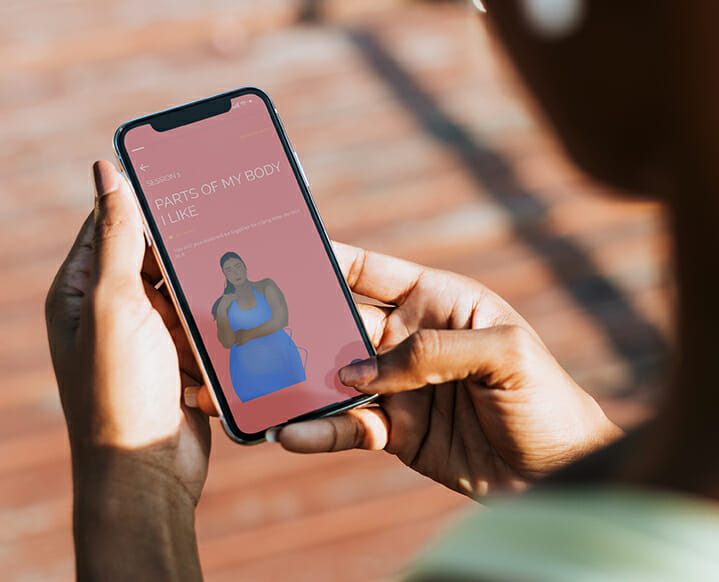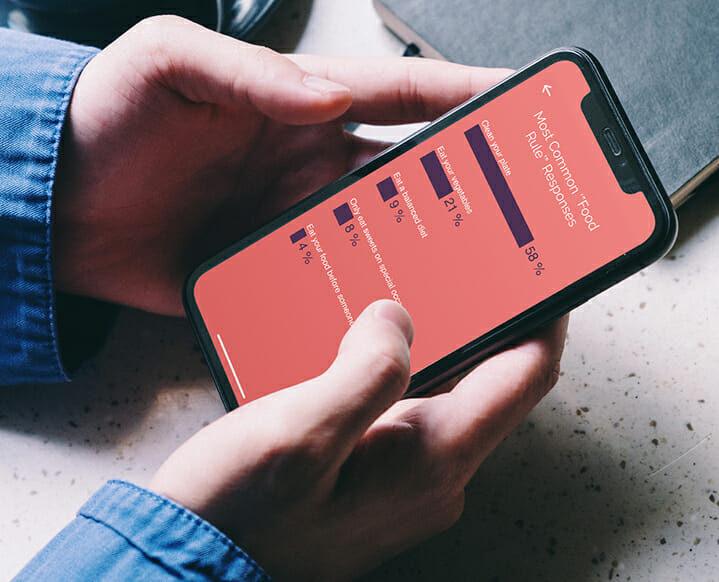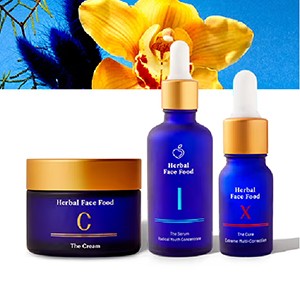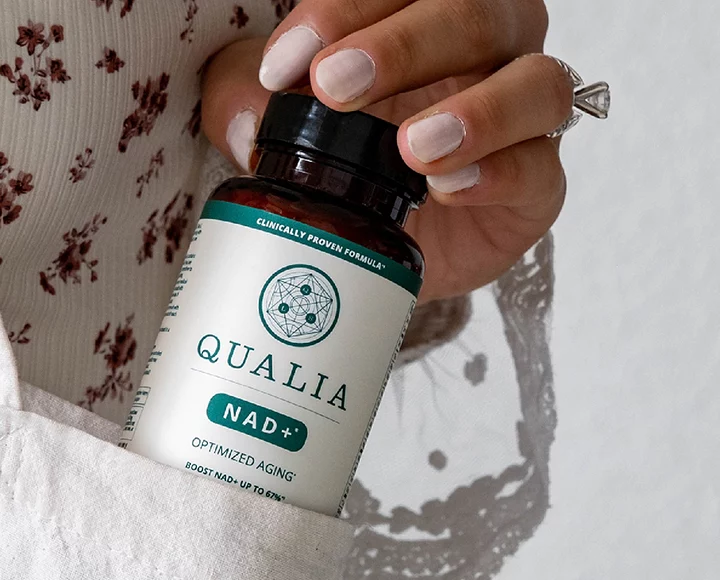When is the last time you felt at peace with your relationship to food? How often do you think about whether what you eat is “good” or “bad”? We’ve partnered with a brand new app, Way to introduce more readers to intuitive eating and to reclaim joy and connection around nutrition and the way we eat every day. Get our exclusive 14 day free trial.
seasons are just seasons and not a signal for some kind of bodily transformation. As we approach the summer months, I remember how this time of year felt in my college years. My peers were obsessed with prepping their bodies for the warmer season, and how that affected our relationship with food wasn’t always so healthy. All throughout the student union there were remarks like, “I went to the gym twice today. Gotta get my summer body in check!” “I only ate X calories today. Vacation body, here I come!” and “I need to burn off the dinner I ate last night. Why did I eat so much?”
Now, in 2023, I’d like to think that we’re living in a post-diet culture, but all too often I’m hearing the familiar nomenclature of those college years repeated. It’s not only because I live in L.A. where body standards are truly ludicrous. It seems that body image struggles and the self-doubt that comes with them are common with my friends no matter where they live.
If you’re looking to break free from these all-too-common challenges with food and body acceptance, the Way app wants to help you slowly unlearn those ways of thinking — and maybe even get you to a place of joy around food again.
Giving Intuitive Eating A Try
One concept that TCM is big on is ‘intuitive eating’. But, as someone who has a history of rules-based eating, I have always been distrusting of intuitive eating as an efficacious way of approaching food. Do I really trust my gut to help me make smart food choices? Will I ever eat a vegetable again if left to my own devices?
What I’ve learned from using the intuitive eating app, Way, is that yes, by shedding some bad habits around food shame and engaging my inner guidance around what, how much, and when to eat, I found a new level of ease. The Way app is not your average nutrition app — and don’t confuse it for a weight loss or diet system. The Way team knows that the journey takes time. The app is designed to make the journey easier, more engaging—and sometimes down right emotional.
The app never asks for your weight, and doesn’t tell you what foods you should or shouldn’t eat. Instead, members get a blueprint for how to change your thinking around food.
With my initial skepticism around intuitive eating in general, I made the perfect guinea pig to try the new app. After a short stint using the service, I’m hopeful that maybe many of us will find our Way on this issue after all.
The Deal With Diet Culture
Most of us are inundated with conflicting messages about food almost every day. The near constant entertainment, social media, and person-to-person dialogue around food bombards us with new diet rules, “What I eat in a day” narratives, and the marketing of new products that can easily send us into overdrive.
The trend toward restricting one’s diet has become deeply entangled with wellness and biohacking culture. In fact, NEDA (National Eating Disorder Association), published a report saying that one in four people who do a restrictive diet develop an eating disorder with at least 35% of people developing disordered eating behaviors.
Way founder Bentley Adams and anti-diet dietician Christine Byrne walked me through the mindfulness practices and behavioral re-training systems that are built into the app.
Way doesn’t call itself an intuitive eating app, but it draws on the ten key concepts of intuitive eating to foster a newfound mind-body connection for users. The goal? A peaceful, positive, and pressure-free attitude toward food that’s evaded many of us for too long. Calorie-counting? Not on the menu.
As a dietician, Christine has been seeing an uptick in two practices: ignored hunger cues and exhaustion through obsessive exercising. “The sessions in Way are all about reconnecting with your body. Learn to listen to the cues your body gives you like hunger, fullness, cravings, needing to move, and needing to rest. People are reluctant to listen to and trust their own bodies, because that’s the opposite of what’s typically sold to us as wellness.”
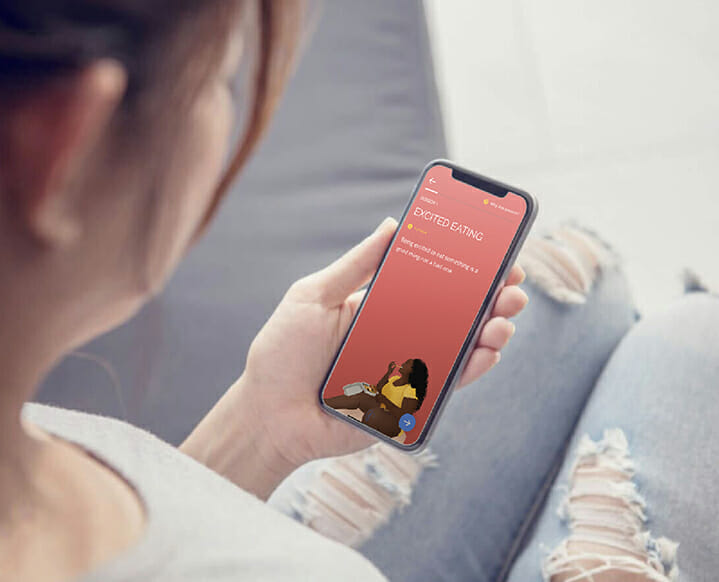
Shifting the mind-body (or food-body) connection is a tall order, but the Way app brings new meaning to the idea of a mindfulness practice. Over time, it literally shifts our behavioral responses to body shaming, food judgement, and restriction. If that’s not major, I don’t know what is!
The Truth About Intuitive Eating
When I first heard about intuitive eating, I assumed it was just a methodology for eating “off-limit foods” like cake and pasta. If one was ‘eating intuitively’, wouldn’t they just accommodate all their cravings? Wasn’t that bad? (I’m a part of the problem!)
Intuitive eating has been around for decades, has over 150 clinical studies proving its efficacy, and continues to gain popularity. The Way app draws on similar principles, like eliminating obsessive thoughts or attachments to diet rules, and learning to listen to and honor your body’s needs for food and movement. The app breaks things down into three distinct pathways that each have a clear focus: body feels, emotional eats, and mindful shifts.
Finding A Way Forward + How I Used The App
So how does Way work? How could an app possibly shift one’s behavior and mindset toward food?
As someone who is obsessed with therapy and all things psychology, I found the app’s deep ties to therapy-based practices incredibly impressive and novel. Way relies on models like Cognitive Behavior Therapy (thoughts lead to feelings, that lead to behaviors, that reinforce thoughts), and a concept they call the Peace Point, a powerful technique used in Dialectic Behavioral Therapy to create new tools for our attitudes toward food.
Initially, I found the idea of “The Peace Point” a little bit too Artist’s Way for me. The Peace Point asks users to imagine what finding peace in their relationship with food and their bodies would feel like in the moment. The biggest surprise for me was that I actually left every session with the app thinking about the prompts:
“What would finding that peace feel like? What would that look like? What would you notice in your surroundings? What would you be eating? How would you feel about your body?”
In incorporating Way as a daily mindfulness practice, I slowly began to notice my perspective and relationship to food shift in small, but impactful ways. That, my friends, is the first step.
Adams explains, “We invite the user to update their Peace Point every six sessions. As you go through the self-exploration and create more understanding around your relationship with food and your body, unconscious patterns and a more refined understanding of your values may arise, and you may want to revise your Peace Point. This has become one of the most potent tools in our user journey.”
Christine shares, “Let’s say you make a food choice that ends up not feeling great for whatever reason—maybe you’re hungry 15 minutes later, over-full for hours, or just feeling blah afterwards—that’s not a failure, it’s just a data point. Learning to notice these data points we how you learn, over time, to make the most informed decisions for yourself in a given situation.”
How To Trial The New Way App
In the world of wellness, the Way app and its daily tools stand out as a compelling self-care practice for anyone who wants support to find peace around their food habits again. Whether you’re struggling with your relationship with food, feel slimed by diet culture and want to break out of bad habits, or are simply interested in reconnecting with the joy of food in your life, Way is a gentle, effective way to remove friction and create a more peaceful lifestyle.
Look forward to:
+ Daily prompts: within the pathways of Body Feels, Emotional Eats, and Mindful Shifts
+ Easy-to-digest facts, foundational information, and reflective exercises
+ Guided body scanning/listening exercises
+ Recorded answers that you can continuously return to
+ Diet culture-free blog posts from Way’s Partners—some of the best anti-diet Dietitians.
+ Just three brief sessions per day so as to avoid overloading the brain
As many as 75% of Americans say they are rejecting restrictive diets, according to Adams. It’s clear that society is looking for a new more emotionally healthy approach to their diets.
Way incorporates the intuitive eating philosophy of “Gentle Nutrition”, safely and mindfully reincorporating nutritional science into a healed relationship to food. That might look like making more informed food decisions without fixation or becoming triggered by information that leads us to a restrict-binge eating cycle.
Join Way in breaking the negative food culture of the past and normalizing a healthier approach to our daily diets. You can try Way for free by downloading the app for a free 7-day trial, after which the service and features are just $6.99/month. Another option is to choose their 14-day trial and pay just one annual fee of $49.99. (The annual route will save you almost $35)
Join the intuitive eating revolution—and tell us what shifts in you once you get a month in!
This story is brought to you in partnership with the Way app. All material on The Chalkboard Mag is provided for educational purposes only. Always seek the advice of your physician or another qualified healthcare provider for any questions you have regarding a medical condition, and before undertaking any diet, exercise or other health-related programs.



